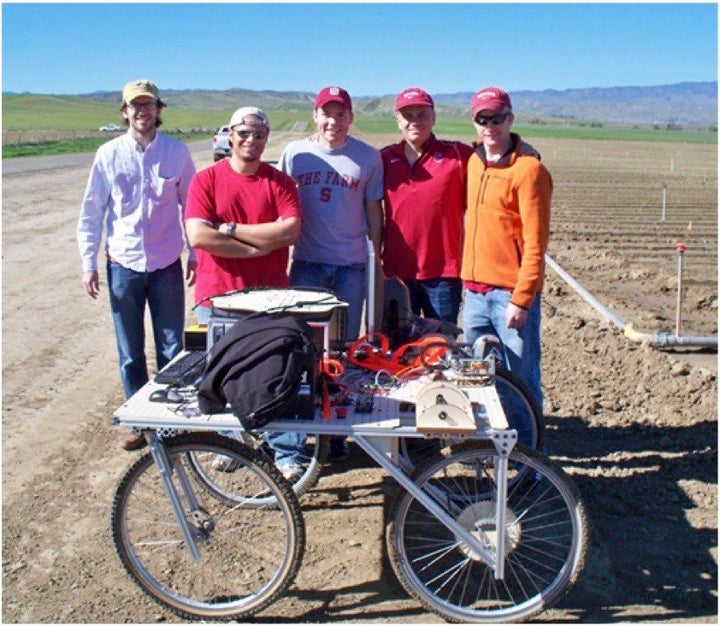Our new Stanford Lean LaunchPad class was an experiment in a new model of teaching startup entrepreneurship. This post is part two. Part one is here. The class syllabus is here.
We asked each of the student teams to:
- Write down their initial hypotheses for the 9 components of their company's business model (Who are the customers? What's the product? What's the value proposition, distribution channel? etc.)
- Come up with ways to test each of the 9 business model hypotheses
- Decide what constitutes a pass/fail signal for the test. (At what point would you say that your hypothesis wasn't even close to correct?)
- Consider if the business is worth pursuing? (Give us an estimate of market size)
- Start the team's blog/wiki/journal to record their progress during for the class
Autonomow's business was a robot lawn mower. Off to a running start, they not only wrote down their initial business model hypotheses but they immediately got out of the building and began interviewing prospective customers to test the three most critical assumptions in any business: Value Proposition, Customer Segment and Channel. Their hypotheses when they first left the campus were:
- Value Proposition: Labor costs in mowing and weeding applications are significant, and autonomous implementation would solve the problem.
- Customer Segment: Owners/administrators of large green spaces (golf courses, universities, etc.) would buy an autonomous mower. Organic farmers would buy if the Return On Investment (ROI) is less than 1 year.
- Channel: Mowing and agricultural equipment dealers
In one week talking to customers, Autonomow's first hypotheses started to shift: "For mowing applications, we talked to the Stanford Ground Maintenance, Stanford Golf Course supervisor for grass maintenance, a Toro distributor, and an early adopter of an autonomous lawn mower. For weeding applications, we spoke with both small and large farms from 40 to 8,000+ acres."
"We got some very interesting feedback, and overall interest in both systems," reported the team. "Both hypotheses (mowing and weeding) passed, but with some reservations (especially from those whose jobs they would replace!) We also got good feedback from Toro with respect to another hypothesis: selling through distributor vs. selling direct to the consumer."
Class feedback: be careful they didn't make this a robotics science project and instead make sure they spent more time outside the building.
To see the slide deck, click here.
Personal Libraries
Personal Libraries proposed to help researchers manage, share and reference the thousands of papers in their personal libraries. "We increase a researcher's productivity with a personal reference management system that eliminates tedious tasks associated with discovering, organizing and citing their industry readings," wrote the team. What was unique about this team was that
, a Stanford postdoc in Neuroscience, had built the product to use for his own research. By the time he joined the class,
was being used in over a hundred research organizations including Stanford, Harvard, Pfizer, the National Institute of Health and Peking University. The problem is that the product was free for end users and few Research institutions purchased site licenses. The goal was to figure out whether this product could become a company.The Personal Libraries initial hypotheses were:
- We solve enough pain for researchers to drive purchase
- Dollar size of deals is sufficient to be profitable with direct sales strategy
- The market is large enough for a scalable business
Our feedback was that "free" and "researchers in universities" was often the null set for a profitable business.
To see the slide, click here.
Agora Cloud Services
The Agora team started with the observation that companies are increasingly looking to cloud computing to reduce their IT infrastructure costs, and but they fear being solely dependent on Amazon Web Services as their only cloud vendor. They observed that a) there's an excess supply of CPU hours available for resale, and b) cloud computing providers are no longer differentiating on the product side. Therefore they will offer a cloud computing "unit" that Agora will buy from multiple cloud vendors and create a marketplace for trading.The Agora initial core hypotheses were:
- Enterprise customers will be willing to purchase hosting capacity in a marketplace
- Excess capacity exists, and potential sellers are incentivized to sell and willing to take the required steps
- Virtualization technology can be developed that is safe, secure and interoperable between different seller machines
D.C. Veritas
The D.C. Veritas team was going to build a new type of Wind Turbine - a Vertical Axis Wind Turbine that could fit in the backyard of houses across the U.S. They wanted to offer low cost, residential wind turbine which average Americans can afford. They wanted to provide a renewable source of energy at affordable price.The D.C. Veritas initial core hypotheses were:
- Not just a product, a complete service (installation, rebates, finance when necessary)
- Reduce the manufacturing cost.
- Cool and Sustainable symbol ("Prius" status)
The Week 2 Lecture: Value Proposition
Our working thesis was not one we shared with the class. We proposed to teach entrepreneurship the way you would teach artists: deep theory coupled with hands-on experience, guided by seasoned, accomplished artists.
Our lecture this week covered Value Proposition -- what problem will the customer pay you to solve? What is the product and service you were offering the customer to solve that problem?
To see the slides, click here.
Next week, each team tests their value proposition hypotheses (their product/service) and reports the results of face-to-face customer discovery. Stay tuned.
Support HuffPost
Our 2024 Coverage Needs You
Your Loyalty Means The World To Us
At HuffPost, we believe that everyone needs high-quality journalism, but we understand that not everyone can afford to pay for expensive news subscriptions. That is why we are committed to providing deeply reported, carefully fact-checked news that is freely accessible to everyone.
Whether you come to HuffPost for updates on the 2024 presidential race, hard-hitting investigations into critical issues facing our country today, or trending stories that make you laugh, we appreciate you. The truth is, news costs money to produce, and we are proud that we have never put our stories behind an expensive paywall.
Would you join us to help keep our stories free for all? Your contribution of as little as $2 will go a long way.
Can't afford to donate? Support HuffPost by creating a free account and log in while you read.
As Americans head to the polls in 2024, the very future of our country is at stake. At HuffPost, we believe that a free press is critical to creating well-informed voters. That's why our journalism is free for everyone, even though other newsrooms retreat behind expensive paywalls.
Our journalists will continue to cover the twists and turns during this historic presidential election. With your help, we'll bring you hard-hitting investigations, well-researched analysis and timely takes you can't find elsewhere. Reporting in this current political climate is a responsibility we do not take lightly, and we thank you for your support.
Contribute as little as $2 to keep our news free for all.
Can't afford to donate? Support HuffPost by creating a free account and log in while you read.
Dear HuffPost Reader
Thank you for your past contribution to HuffPost. We are sincerely grateful for readers like you who help us ensure that we can keep our journalism free for everyone.
The stakes are high this year, and our 2024 coverage could use continued support. Would you consider becoming a regular HuffPost contributor?
Dear HuffPost Reader
Thank you for your past contribution to HuffPost. We are sincerely grateful for readers like you who help us ensure that we can keep our journalism free for everyone.
The stakes are high this year, and our 2024 coverage could use continued support. If circumstances have changed since you last contributed, we hope you’ll consider contributing to HuffPost once more.
Already contributed? Log in to hide these messages.

